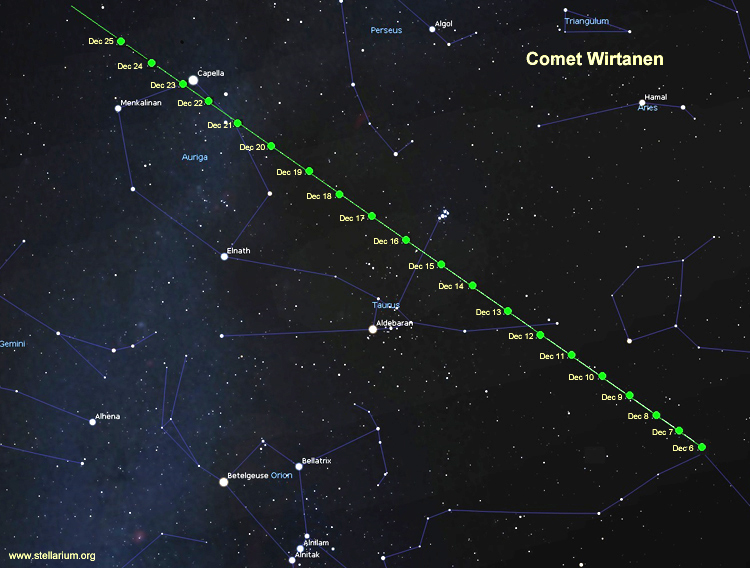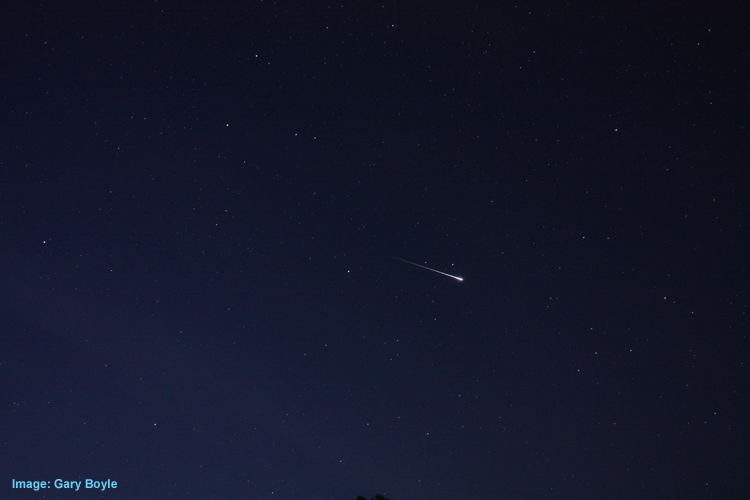Two Grand Events
This year ends with two fantastic celestial sky shows. First is the long-anticipated return of Comet 46P/Wirtanen. Discovered in January 1948 by Carl Wirtanen at the Lick Observatory and one of three he discovered, this 1.2 km wide ice rock was found to have an orbital period of 6.7 years. Close passes in 1972 and 1984 with the planet Jupiter altered its path to its present 5.4-year orbit. Comet Wirtanen comes unusually close this month to within 11.4 million km of Earth (0.078 AU) on December 16. This will be just four days after passing the sun. This places Comet Wirtanen in the top ten closest approaches of a comet to the earth in the space age and twentieth in history.
This small and hyperactive comet is now an easy binocular object low on the southern horizon and is climbing quickly. The green coma has already been measured to be larger than the full moon and it is expected to double in size over the next couple weeks. The comet might peak as high as 3rd magnitude making the comet a possible naked-eye target from the suburbs and a spectacular object from the countryside. However, comets can be unpredictable in their brightness estimates. On December 15, Wirtanen will be nicely positioned between the Pleiades and Hyades star clusters. The moon will set around midnight local time that night allowing for dark conditions for astrophotographers. On its trek up the sky, the comet comes very close to the star Capella on December 23.

We then have the annual Geminid meteor shower. I consider the Geminids to be the best shower of the year. Factors include its rate of 120 meteors seen per hour and a slow re-entry speed of only 35 km/sec compared to the Perseids seen in August at twice that speed. The Geminids have been known to produce fireballs as larger-sized particles completely burn up in the upper atmosphere producing long yellow streaks that can light up the ground. The origin of the meteors or the radiant is located near the star Castor. The shower peaks on the night of December 13/14 with the best viewing time after midnight until dawn. The 36% Moon sets around 10 p.m. local time so the night will remain dark. The only drawback is obviously cold weather. As long as the wind stays calm, you should have a great night observing. With wide-angle photography centred on the comet, you might capture a Geminid or two in the same field of view.
The winter sky with Orion the Hunter takes centre stage. Amongst the constellations of Orion, Auriga, Gemini, Canis Minor, Canis Major and Taurus, we see a dozen bright stars. With Orion’s belt located on the celestial equator, the Hunter is perfectly placed to be seen in both the northern and southern hemispheres of the world. Along with the imaginary sword that hangs off his belt (3 stars) is a fantastic birthplace of stars – the Orion Nebula. Located 1,500 light-years away, this area of gas and dust is slowly forming hundreds of stars.

Mars is still visible low in the western sky and sets at midnight on the 1st. Compared to is great show this past summer when it was 59 million km on July 31, the red planet is now more than 152 million km from us as we are separating at 12 km/sec. Venus is extremely bright in the morning sky at magnitude -4.9. In a telescope, you will see a lovely 27% crescent. On the morning of December 3, the crescent moon will be located north of Venus. Using the moon as a guide, try to follow Venus throughout the day in binoculars or if the blue is a deep blue – with the unaided eye. I once had superb seeing conditions in Kelowna BC years ago and found it a few hours before sunset.
And if a telescope is on your shopping list for yourself or the young astronomer, may I suggest to seek out reputable telescope dealers in your area or on the Internet and try to stay away from the camera and big box stores.
The winter solstice occurs on the 21st at 22:23 Universal Time. The new moon occurs on December 7 and the Full Cold Moon on the 22nd.
Until next month, clear skies everyone.
